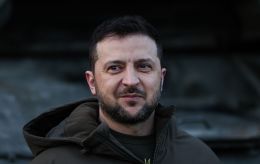Europe struggles to assemble 25,000 troops for Ukraine mission – The Times
 Photo: British Chief of Defense Staff Admiral Tony Radakin (Getty Images)
Photo: British Chief of Defense Staff Admiral Tony Radakin (Getty Images)
European countries will struggle to mobilize 25,000 servicemen to participate in the deterrence mission in Ukraine. The reason is the chronic shortage of personnel and insufficient funding of the armies, according to The Times.
Plans of the Coalition of the Willing
Media outlet The Times gained access to rare discussions between defense ministers and military chiefs of European countries. At the meetings, the plan to create a Coalition of the Willing was discussed — a volunteer contingent that, in the event of a peace agreement, would be deployed to Ukraine.
The Chief of the Defence Staff of the United Kingdom, Admiral Tony Radakin, called to assemble a contingent of up to 64 thousand servicemen. London expressed readiness to provide up to 10 thousand people.

Reaction of allies: even 25 thousand is a challenge
At the following meetings in Brussels, defense ministers from European countries admitted that gathering 25,000 people would be extremely difficult. One source noted that such figures could only be a stimulus for joint work but, so far, seem unrealistic.
According to The Times, the United Kingdom and France now lean toward sending instructors and training units to western Ukraine rather than a full-fledged multinational ground contingent.
Shift in focus: training instead of combat missions
Allies now are focusing on:
-
training Ukrainian troops,
-
rearming the Armed Forces of Ukraine,
-
ensuring protection from air and sea threats.
They avoid deploying troops near the front line or critical infrastructure facilities.
Allies’ concerns
At the meeting on April 10, ministers expressed concern about London's ambitions. For example, the Lithuanian Minister of Defense, Dovilė Sakalienė, directly stated:
"Russia has 800,000 [troops]. Let me tell you this, if we can’t even raise 64,000 that doesn’t look weak — it is weak."
Her speech was described by participants as "sharp but inspiring."
Problems with logistics and rotation
Allies pointed out that supporting a contingent of 64 thousand people would require up to 256 thousand servicemen, taking into account rotation.
This causes skepticism, especially amid current constraints:
-
Estonia and Finland fear weakening their own defense,
-
Poland, Spain, and Italy refused to send soldiers,
-
Germany and Finland opposed it, although Berlin does not completely rule out participation.
European dependence on the USA
The discussions also highlighted Europe’s deep dependence on the USA in matters of deterring Russia. One participant suggested using special forces, since their deployment does not require parliamentary approval.
Problems of the British Army
Sources noted that the British army is facing:
-
personnel cuts,
-
shortage of artillery,
-
logistical problems — in particular, dependence on American trucks and equipment.
What will happen instead of the contingent
According to current plans:
-
The United Kingdom and France will deploy military instructors in western Ukraine;
-
they will not guard key facilities or engage in combat;
-
the main focus will be the training of Ukrainian forces and strategic planning in case of escalation.
UK Ministry of Defence statement
"Advanced operational planning within the ‘coalition of the willing’ remains ongoing for options across land, sea and air, and to regenerate the Ukrainian armed forces. In the meantime, we’re continuing to support efforts for peace, while stepping up military support for Ukraine as Putin’s illegal invasion continues," the UK Ministry of Defence stated.
Earlier, The Times reported that the United Kingdom would likely abandon plans to send thousands of military personnel to Ukraine due to the high risks associated with such an operation.

